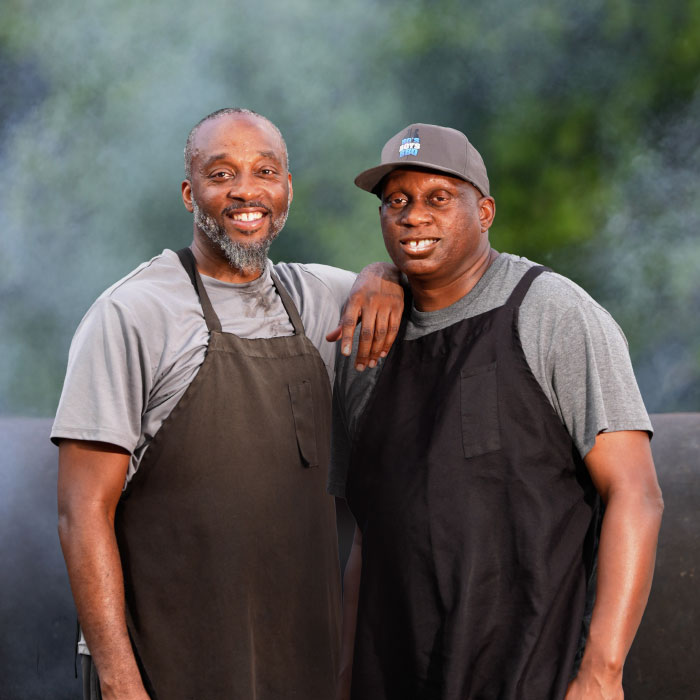Feature
Tri Angles
A local couple finds their lane:
A triathlon love story
- Heather Anne Lee
- Fred Lopez

If you were to ask Andy and Stephanie Clark about the first time they met, you might expect a story filled with romantic flourishes—a mutual appreciation for the same obscure hobby or a spark of instant connection. Instead, it goes something like this:
Andy was minding his business in a Miami bike shop one afternoon, engaged in what he later describes as a “perfectly unremarkable” conversation with the shop owner. Enter Steph, a tiny, determined blonde with an unshakable focus on her bike. She breezed past him without so much as a glance.
“I was mid-conversation,” Andy recalls, laughing. “And she acted like I wasn’t even there.”
“He’s right. I wasn’t there to meet people,” Steph quips. “I needed my bike fixed.”
Weeks later, they crossed paths again at one of Andy’s triathlon training sessions. Steph, nervous but determined, introduced herself to the group: “I’m Stephanie, and I’m doing Ironman Brazil—and I’m terrified.”
Everyone laughed because, honestly, they were all terrified. It was (and is!) a massive, overwhelming challenge. But Andy? He was drawn to her raw honesty and drive.
“That’s what the sport is about,” Andy reflects. “Facing your fears and discovering what you’re made of.”
The two didn’t really hit it off right away. The romantic meet-cute was more of a slow burn. But in retrospect, perhaps it was inevitable. They both found themselves drawn to triathlon, a sport that, as it turns out, has a peculiar way of creeping up on you when you least expect it.
“It’s not just about swimming, biking, and running. It’s about managing fear and proving to yourself you can do hard things.”
Why Triathlon? Why Now?
If you’ve never dabbled in triathlon, the idea of swimming, biking, and running all in one event might seem a bit … well, mad. You might also be wondering: Why would anyone in their right mind take it up, especially in their late 20s or 30s?
For Andy and Steph, the answer is simple: It just seemed like the right thing to do at the time—when life was settling down a bit, when the “wild” days of youth were firmly behind them. Andy was in his late 20s when he first tried a duathlon, the cousin of triathlon that doesn’t involve swimming. Steph, on the other hand, found herself drawn to triathlon at age 25, but it wasn’t until her first Ironman at 28 that she truly committed.
“It wasn’t just about getting fit,” says Steph, looking back. “It was about finding something that would shift my entire lifestyle. I was tired of all the late-night parties. I wanted purpose.”
And Andy? “My younger brother told me I couldn’t do it,” he says with a grin. “So, naturally, I had to prove him wrong.”
Before triathlon took over his weekends and wardrobe, Andy was already deeply immersed in the world of fitness. As a personal trainer and studio owner, he spent his days guiding clients through their own transformations. Little did he know that a dare would lead him to his own—and eventually to coaching a whole new kind of athlete full time.
After his first race, he became hooked on endurance sports, which led to training more endurance athletes. And when clients at his personal training studio began asking for help with triathlon prep, he designed a 12-week program.
“It was simple—weekly workouts and Saturday meetups,” he says. “But 27 people signed up, and every single one of them finished their race. Seeing that success was addictive. It made me want to help more people crush their goals.”
Andy’s natural ability to break down the overwhelming task of triathlon turned him into a full-time coach. “It’s not just about telling people what to do,” he says. “It’s about giving them a path through the unknown. Triathlon can be terrifying. It’s not like hopping on a treadmill. But with the right guidance, people can conquer the unknown.”
For Steph, who initially described herself as “just a spin class girl,” triathlon was equally life-changing. “It’s not just about swimming, biking, and running,” she says. “It’s about managing fear and proving to yourself you can do hard things. Andy was able to do that for me as my coach, and now I get to share that myself with people new to the sport.”
The Social Side of Triathlon
There’s an old saying that triathletes are just regular athletes who like to suffer. It’s not entirely untrue. The training is relentless, the races are long, and the rewards—well, they’re not exactly instantaneous. But despite (or perhaps because of) the hardships, triathlon has a unique way of creating lasting bonds.
Andy and Steph know this firsthand. “All of our closest friends came from our triathlon club. When you spend weekend after weekend together, those people become family.”
When Andy and Steph moved to Winter Garden to raise their family in 2021, they quickly realized something was missing: the deep sense of connection and camaraderie they’d built through their tri community. Determined to recreate that bond—and to inspire others to discover the life-changing power of the sport—they decided to start a triathlon club right in their new hometown.
Clermont, just down the road, is already celebrated as a triathlon hotspot, drawing athletes from around the world to train and compete. But Winter Garden? “It’s a blank slate,” says Andy. In fact, Andy and Steph believe their club might just be the town’s very first triathlon club—”we think,” they say with a laugh.
Either way, the purpose is simple: make the sport more accessible and bring people together.
“You don’t need fancy gear,” Steph says. “When I did my first race, I had a basic road bike, five-dollar goggles, and running shoes. It’s not about perfection—it’s about progress.”
That philosophy is central to their coaching. “Start small,” Andy emphasizes. “You don’t need to be perfect from the beginning. It’s about consistency and showing up. Everything else will fall into place.”
To help newcomers get started, Andy and Steph created a 12-week beginner-friendly training program launching in February. “We focus on the essentials,” Andy explains. “What gear do you really need? How do you manage open-water swim anxiety? What’s the right way to pace yourself on the bike? We take what feels overwhelming and make it manageable.”
Their offerings include open-water swim clinics, nutrition workshops, and plenty of encouragement, all delivered with their signature blend of expertise and fun. All of which will lead to the group’s first triathlon at Sommer Sports on June 15.
Their training group will most certainly blend first-timers with seasoned athletes, each tackling their own goals but united by shared experiences. “There’s something magical about it,” Andy says. “It pushes you physically, mentally, and emotionally. It forces you to get uncomfortable—and that’s exactly what many people are looking for as they get older. They want to see what they’re made of.

Still, for beginners, middle aged or otherwise, the process can seem daunting. “The biggest hurdle is fear,” Andy admits. “The swim, the bike, the run—all of it feels overwhelming. But when you break it down and help someone through that first step, it’s magical.”
Steph still remembers her first race vividly. “I was so nervous before the swim I threw up,” she admits. “But when I crossed the finish line? It felt like Christmas morning. All that fear, all that hard work—it was worth it.”
But let’s not romanticize it too much. Triathlon is not for the faint of heart. It’s one thing to look at the glistening, well-groomed athletes racing through transition zones, but it’s another thing entirely to actually do it.
In 2025, Steph will be competing in her 27th Ironman, the World Championships in Kona. For her, every race is a celebration, not just of finishing, but of the journey. But she still feels nervous when she walks up to the start line.
“I have to remind myself that the race isn’t the end. It’s the start of the next journey,” she says. “Every step of the way is a victory. You don’t just cross that finish line; you look back at everything that got you there.”
For Andy, the real reward isn’t crossing his own finish line—it’s watching others cross theirs. “Triathlon is a mirror,” he says. “It reflects who you are at your core. It shows you what you’re made of and forces you to confront your doubts and fears. It’s about pushing past your limits, challenging yourself in ways you never thought possible, and coming out on the other side stronger, more confident, and more resilient. Seeing someone go through that transformation—watching them realize they can do something they once thought was impossible—is what makes it all worth it.”
If you’re wondering whether you can do it too, the answer is simple. “You can,” says Andy. “It’s not about perfection—it’s about showing up and taking it one step at a time.”








